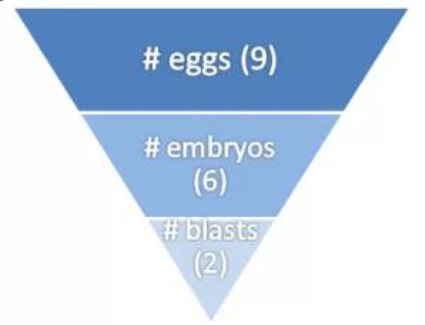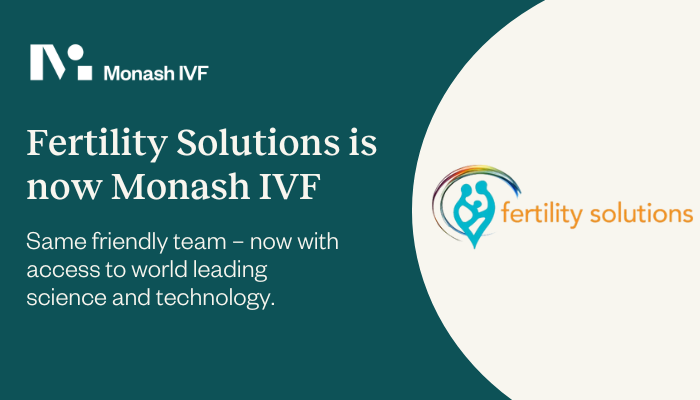It is important to understand that not every follicle seen on an ultrasound scan during an IVF cycle will have an egg collected from it. It is expected that approximately 60-80% of follicles will yield an egg.
Occasionally there may be fewer eggs collected at the egg collection than might be expected and in some situations, there can be no eggs. Having no eggs collected is sometimes seen when there are a low number of follicles noted on the final scan before egg collection i.e. four or less. Once the eggs have been collected, not every egg will fertilise. It is expected that approximately 60-80% of eggs will fertilise. However, once an egg has been fertilised, it does not necessarily mean it will be suitable for transfer or freezing. Some embryos will grow until Day 2 or 3 (cleavage) and look perfectly normal, but do not progress after this stage.
To demonstrate this, from the eggs that do fertilise it is expected that approximately 1/3 of these will reach day 5/6 (called the Blastocyst stage). So, if 9 eggs are collected, it would be realistic to expect that approximately 6 eggs would fertilise. However, only 2 of these embryos may progress to day 5/6. Once the embryos have reached this stage it does not necessarily mean they will be suitable for transfer or freezing. It’s important to realise that these results are very individual.
IVF: It’s A Numbers Game
When you are expending so many resources (financial, physical, and emotional) on assisted reproductive techniques such as IVF, it is natural to expect some guarantees in return for these investments. In the lab, we are often faced with questions about success rates and requests for certain outcomes and we find ourselves having to answer with caution, as no two scenarios or situations are the same. Nor can we predetermine how each cycle will progress, even if you have had a cycle previously. In short, unfortunately, we are not able to confidently provide any guarantees. What we can do is give you an idea of what to expect from your IVF cycle by employing a general rule of thumb based upon average results seen across all IVF clinics. This often means having to re-adjust a couple’s expectations to a more realistic scenario.
The rule is essentially IVF’s very own rule of thirds. Let’s start with fertilisation rates. Some would liken IVF to shooting fish in a barrel, you put sperm and eggs together saving the sperm a long and tiresome swim (IVF) and in some cases you may even put a sperm inside an egg (ICSI) so you would expect fertilisation to be nothing short of 100%. In reality, on average, two thirds of mature eggs will fertilise (i.e. 60-70% or 6/9 eggs). From there, most fertilised embryos should progress well for the first 2-3 days.
It is generally from Day 3 onwards where there will be another adjustment in numbers, and this is generally where the largest decrease will occur, with around one-third of embryos progressing successfully to the blastocyst stage (Day 5/6 of an embryos time in culture). Using the previous example, of the initial six embryos which fertilised we would expect two to still be meeting the expected milestones by Day 5/6, with the remaining four either arresting or delayed at earlier developmental stages. These four delayed embryos will not be able to create a healthy pregnancy, as a blastocyst is essential for a chance at a pregnancy and so six now becomes two.
As you can imagine, this information is generally received with disappointment; an earlier investment of 9 eggs resulting in only 2 good embryos is not seen as the best return. But the good news is it gives you the best odds of success: If an embryo can make it to a good quality blastocyst, then the chances of pregnancy are improved immensely because you have selected out the most likely to succeed. This ultimately gives you the best chance of a pregnancy in the shortest time possible. It is a poignant example of the principle “survival of the fittest”.
In our scenario with two blastocysts, ideally, one would be transferred, with the second hopefully meeting criteria for freezing, providing a second opportunity for a pregnancy in the future. Of course, there are always going to be exceptions to this rule, sometimes for the better and unfortunately, sometimes for worse.
It is natural to then assume that retrieving 18 eggs, or as many eggs as possible, would result in a better return on your investment, essentially an expectation of four blastocysts, but this is actually not the case. IVF management requires a fine balance and studies suggest that collecting approximately 15 oocytes gives the best chance of a live birth, however this too needs to be managed with reducing a patients chance of ovarian hyper-stimulation.
If you would like to speak with one of our fertility nurse specialists or scientists, we offer a free initial phone or face to face chat. Please call the clinic on 1300 FERTILITY, today.




